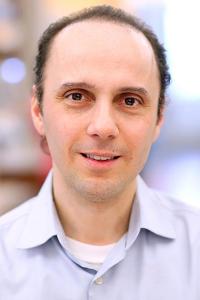Thomopoulos Lab
Principal Investigator
The Mechanical Challenge of Attaching Tendon to Bone
The attachment of dissimilar materials is a major challenge because of the high levels of localized stress that develop at such interfaces. An effective biologic solution to this problem can be seen at the attachment of tendon (a compliant, structural “soft tissue”) to bone (a stiff, structural “hard tissue”).
The enthesis, a transitional tissue that exists between uninjured tendon and bone, is not recreated during healing, so surgical reattachment of these two dissimilar biologic materials often fails (e.g., recurrent tears after rotator cuff repair range from 20% to 94%, depending on the patient population). To develop successful strategies for tendon-to-bone repair, necessary for rotator cuff repair and anterior cruciate ligament reconstruction, we must first understand the mechanisms by which the healthy attachment transfers load between tendon and bone, and how cells build a functional attachment during development. In order to achieve these goals, we are focusing on:
- Understanding the structure-function relationships that allow for effective load transfer at the healthy enthesis,
- Determining the biophysical and molecular cues that drive the development of the enthesis,
- Developing regenerative medicine strategies motivated by structure-function and developmental biology results, and
- Applying these strategies to improve tendon-to-bone healing.
Conclusions
The four research themes described above inform each other and are expected to lead to clinical therapies for tendon-to-bone repair. Basic science studies will identify the critical features necessary for successful tendon-to-bone repair and inform translational studies on cell- and growth factor-based regeneration for rotator cuff repair and anterior cruciate ligament reconstruction. Of critical importance is recreation of the multiscale mechanical behavior derived from the hierarchical structures at the healthy tendon-to-bone attachment.

